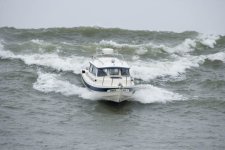I'm not sure how a 22 is laid out regarding the aft bilge. However, it seems that the bilge pump should take care of any water in the cockpit, much better than any scupper drains. On my last sailboat, the cockpit was open through the transom, and any water that came in just flowed out, no pause. On the C-25, those two 1" drains, with a 2" head don't drain much. However, when the water drains to the bilge pump, there's a rather sturdy stream coming out. Instead of blocking off the cockpit, I'd assume that one would make sure that the water could easily reach the bilge pump. In fact, the scuppers are blocked off most of the time, to keep water from flowing in.
In summary, it's not the scuppers that keep you dry, it's the bilge pump.
Boris

